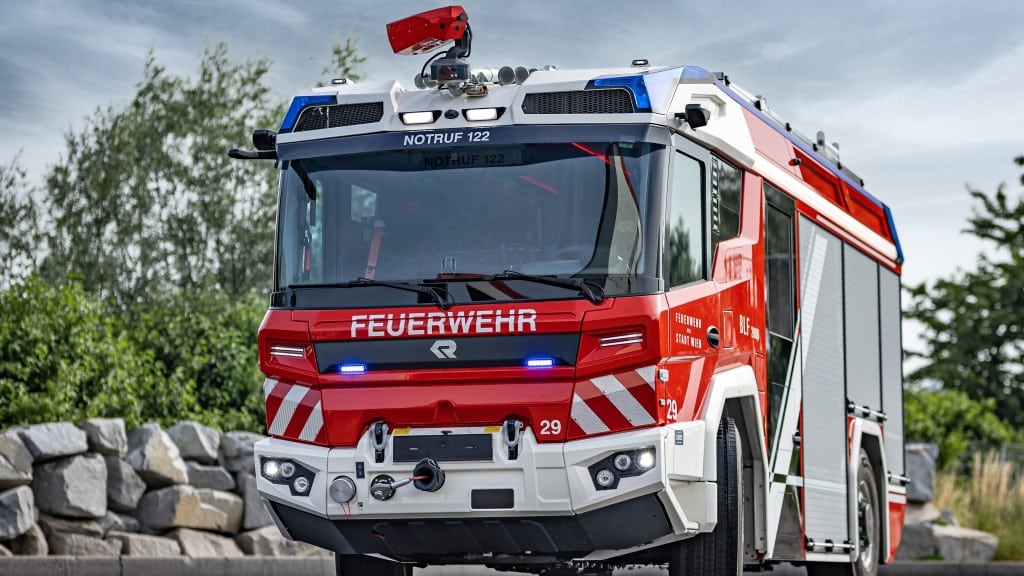Vienna acquires two electric firefighting vehicles in a drive towards sustainability
- June 26, 2023
- 9:59 am


Iain Hoey
Share this content
Vienna marks another milestone in firefighting history
The City of Vienna’s Fire Department and Civil Protection has recently procured two cutting-edge electric firefighting vehicles, strengthening their commitment to sustainability and environmental consciousness. This development was unveiled at the Landstrasse fire station by Peter Hanke, Vienna’s City Councilor for Fire Services, Fire Director Mario Rauch, and Andreas Zeller, the Chief Sales Officer of Rosenbauer International AG.
Almost 120 years ago, Vienna’s Professional Fire Department made history by incorporating the first electric fire truck into their fleet. This seminal electric vehicle, currently preserved and maintained in working condition by the Vienna Fire Brigade Museum, was presented alongside the current collection of electric vehicles from the city’s fire department.
Vienna leads Austria’s innovative firefighting sector
The vehicles were produced by Rosenbauer, a renowned manufacturer who has so far delivered 21 units of this new electric vehicle worldwide. With this recent addition, Vienna’s Professional Fire Department takes a substantial step forward, positioning itself as a leader in innovation within the Austrian firefighting industry.
Unveiling the future of firefighting with electric Basic Firefighting Vehicles (BLFs)
The new Basic Firefighting Vehicles (BLFs) are powered by a high-capacity 66 kWh battery, neatly housed at the bottom of the vehicle. With two electric motors, these vehicles can produce a whopping 360 kW of peak electric drive power. In anticipation of longer missions or potential power outages, these BLFs come with a 225 kW Energy Backup System (EBU) and successfully blend the capabilities of both rescue and tank firefighting vehicles.
Vienna Fire Brigade takes a step towards climate neutrality
“Thanks to its high level of professionalism, the Vienna Professional Fire Brigade rightly ranks among the best emergency services in the world. By gradually switching to environmentally friendly vehicles, it is also making a contribution to a climate-neutral Vienna. This is important because the commitment to the safety of the Viennese population also requires constant further development and the use of new technologies,” stated Peter Hanke, the Fire Department City Councilor.
A journey of eight years of innovation and development
The vehicles’ rollout comes after eight years of development, which Andreas Zeller describes as a “challenge as big as the development work behind it.” He also emphasised their redundant energy supply, which makes these BLFs “particularly crisis-proof firefighting vehicles,” enabling “virtually emission-free operations.”
Equipping the future of firefighting
These state-of-the-art vehicles are not just about emission-free operations; they also herald a new approach to the equipment onboard. The objective was to replace corded or combustion engine devices with battery-powered ones, subjecting new products to practical tests in everyday operations.
“The BLF concept is holistically innovative. The basic idea of those responsible for tactics and technology was to expand the vehicle’s range of applications and make it as universal as possible. The firefighters are already looking forward to testing the new vehicles, equipment and technologies in their everyday work. The feedback we receive from them is and always has been a key driver for further development and improvement of the vehicles and equipment,” expressed Fire Director Mario Rauch.
The innovative BLFs, with dimensions of approximately 7,800 x 2,350 x 3,200 mm and a total weight of 16,000 kg, sport a 4×4 Rosenbauer RT Basic chassis with selectable ride levels for comfortable entry and ergonomic removal. They are equipped with an electric drive system and an Energy Backup System, and also feature an impressive extinguishing technology setup, including a built-in pump, water tank capacity of 2,000 litres, foam tank capacity of 100 litres, and a water cannon for water and foam operation on the cabin roof. They also possess an electrohydraulic cable winch and an integrated generator for external equipment.
In procuring these advanced electric firefighting vehicles, Vienna not only demonstrates its commitment to sustainability and environmental protection but also paves the way for the future of firefighting.
(Source: Rosenbauer)



